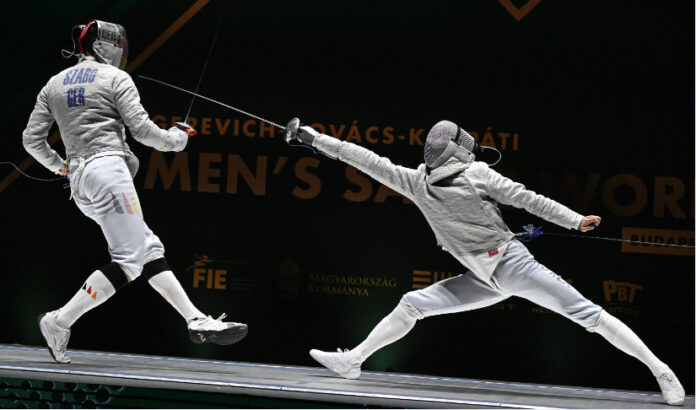I should preface that the conclusion of this article is absolutely biased. I am myself a Saber fencer, and I wholeheartedly believe that it is the superior fencing style. The goal of this article is to review the differences between the different styles of fencing and to explain why I believe that Saber is the best fencing style.
Context
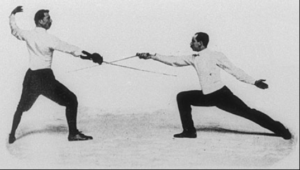
Fencing was one of the original five sports of the modern Olympics (the other four are athletics, cycling, gymnastics, and swimming). The Olympics recognizes three distinct styles of fencing: Foil, Epee, and Saber. Other styles do exist, and include Victorian and Lightsaber (yes, this is in fact an official style of fencing in France, and it is awesome). However, these three are the only styles recognized by the Olympics and are by far the most popular.
Rules of the Game
All three forms of fencing take place on a 14m X 1.5m stretch known as the “strip” or the “piste.” Each bout (game) is played until one participant reaches 15 points. A designated referee awards points for touches and cards for penalties (penalties vary and can be triggered by a variety of events, including false starts, stepping of the strip, and the use of unnecessary aggression). Each style also has rules and procedures particular to them, which I will now cover.
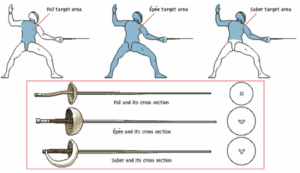
Foil
Foil is the most popular style of the three, and the most prominent. In Foil, the hitbox is both the front and back of the torso and excludes all appendages and the head. The weapon is referred to as a foil (all three styles are named after the weapon). It is 110 cm in total, with the blade being 90 cm and the grip being 20 cm. The standard grip is a pistol grip. In foil, touches can only be made with the point of the blade; additionally, a system known as “right of way” is used, where, in the event that both combatants successfully touch their opponent, only the person with the right of way (also known as the attacker/aggressor or the person with priority) gets the point.
Epee
Epee is the style that the Jesuit Fencing Team uses. In Epee, the entire body is a hitbox. The weapon follows the same dimensions as the foil (although the blade is much heavier, at an average of 27 ounces compared to the foil, which typically comes in at just under 1 pound). In my experience, most Epee fencers use a french grip instead of a pistol grip. However, the pistol grip is still common. In Epee, like foil, touches may only be scored by hitting your opponent with the tip of the blade. However, Epee is the only style that does not enforce right of way. This means that in the event that both fencers successfully score a touch, they can both receive points.
Saber
Saber is the final, and in my (definitely very humble) opinion, the objectively best (and coolest) of the three fencing styles. In Saber, the hitbox is from the waist up. This allows for hits to the arms, chest, back, and head. Hand and everything below the waist is off limits. The weapon is 105 cm in length, with the blade being 88 cm and the grip being 17 cm. Due to being smaller than the epee and foil, the saber is the lightest of the three weapons. Saber is the only of the three styles that allows for slashes and cuts in addition to the point. Because of this, pistol grips are not legal, and only the French grip is used. Additionally, the guard and overall style of the saber is modeled after a cavalry sword. Saber fencing, similar to Foil, enforces right of way.
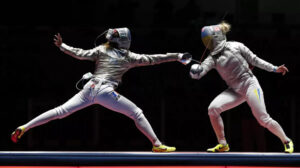
Why is Saber Better?
Combativeness
I have many reasons for why I believe Saber to be the best style of fencing, but the biggest reason is that I feel Saber is the best combat sport of the three. Epee, for example, has developed into a very slow sport, where both fencers wait and make tiny movements until one of them makes a mistake (this is the result of the heavy blade and the entire body being the hitbox). In fact, fencers were so non-combative that a new rule had to be created that required the fencers to interact or face a penalty.
On the other hand, the saber’s light blade, waist-up hitbox, and its enforcement of right of way (point goes to the attacker) have fostered a quick and aggressive sport that is exhilarating to both watch and participate in. As for foil, it does enforce right of way, but fencers can only hit with the point of the blade (this also goes for Epee) which slows down the sport significantly. Additionally, in Foil fencers are allowed to cross their feet without losing right of way, which allows fencers to exit an attacking position and then resume it before actually starting their attack.
Blade Restrictions
I find that being forced to only use the point can be a miserable experience. For example, some foil fencers will employ the strategy of getting extremely close to their opponent as a defensive mechanism. This forces fencers into contorting their arms and struggling to land the tip of the blade against their opponent due to their proximity. This problem, and other similar problems, are non-existent in Saber. Because the side of the blade can be used in addition to the point, a stunt like this would be swiftly punished.
Personal Assessment
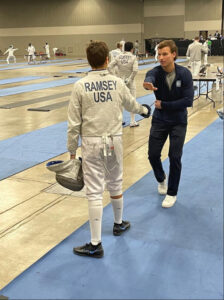
And finally, Saber is my favorite style of fencing for the simple (and totally unbiased) reason that I love it. I have been a Saber Fencer for about two years, and every practice I learn something new and exciting. Saber fencing is incredibly fast-paced and adrenaline-inducing, and the thrill of fencing is a completely unmatched feeling. Saber fencing is an addictive feeling that is a mixture of acute concentration, harsh anger, fearful timidity, and uncontrollable excitement and joy. While fencing in any style is sure to be incredibly fun, Saber fencing will forever be my favorite.


